Assessment of the Mechanical Properties of High Strength Mortar Incorporating Silica Fume and Graphene Nanoplatelets: Experimental and Mathematical Modeling
Abstract
1. Introduction
2. Materials and Theoretical Program
2.1. Materials
2.2. Mix Design Proportions
2.3. Compressive Strength Test
2.4. Flexural Strength Test
2.5. Microstructure Test
2.6. Optimization Modelling
3. Results and Discussion
3.1. Mechanical Properties Analysis
3.2. Microstructure Analysis
3.3. Optimization Using RSM Model
4. Conclusions
- I.
- The optimum mortar mixture was designed with a cement-to-sand ratio of 1:1.5 by mass and a water-cement ratio of 0.32, which was effective in achieving the target strength (more than 80 MPa).
- II.
- The highest mechanical properties were achieved when the graphene content was 1.5%, and when the cement replaced by silica fume was 10%.
- III.
- Increasing the content of GNPs by more than 1.5% caused a reduction in compressive and flexural strength.
- IV.
- The presence of nanographene flakes showed their ability to fill the mortar pores, which was supported by FESEM. The sharp hexagon shapes of the GNPs have appeared and played a significant role in improving the concrete.
- V.
- The RSM model showed its ability to predict accurate results in which MAPE and SI were less than 0.11. The RSM model also showed a strong correlation between the predicted and experimental results in which R2 is greater than 0.9.
Author Contributions
Funding
Institutional Review Board Statement
Informed Consent Statement
Data Availability Statement
Acknowledgments
Conflicts of Interest
References
- Wang, B.; Gupta, R. Analyzing bond-deterioration during freeze-thaw exposure in cement-based repairs using non-destructive methods. Cem. Concr. Compos. 2021, 115, 103830. [Google Scholar] [CrossRef]
- Algaifi, H.A.; Bakar, S.A.; Alyousef, R.; Sam, A.R.M.; Alqarni, A.S.; Ibrahim, M.H.W.; Shahidan, S.; Ibrahim, M.; Salami, B.A. Machine learning and RSM models for prediction of compressive strength of smart bio-concrete. Smart Struct. Syst. 2021, 28, 535–551. [Google Scholar]
- Chetty, K.; Watson, M.; Raine, T.; McGurgan, T.; Ladislaus, P.; Chen, J.; Zhang, S.; Lin, L.; Jiang, G. Enhancing Concrete and Mortar Properties and Durability Using Pristine Graphene Particles. Coatings 2022, 12, 1703. [Google Scholar] [CrossRef]
- Feng, H.; Chen, G.; Gao, D.; Zhao, K.; Zhang, C. Mechanical properties of steel fiber-reinforced magnesium phosphate cement mortar. Adv. Civ. Eng. 2018, 2018, 3978318. [Google Scholar] [CrossRef]
- Mu, R.; Li, H.; Qing, L.; Lin, J.; Zhao, Q. Aligning steel fibers in cement mortar using electro-magnetic field. Constr. Build. Mater. 2017, 131, 309–316. [Google Scholar] [CrossRef]
- Dawood, E.T.; Ramli, M. High strength characteristics of cement mortar reinforced with hybrid fibres. Constr. Build. Mater. 2011, 25, 2240–2247. [Google Scholar] [CrossRef]
- Khan, M.; Jamil, M.; Karim, M.R.; Zain, M.F.M.; Kaish, A.B.M.A. Filler effect of pozzolanic materials on the strength and microstructure development of mortar. KSCE J. Civ. Eng. 2017, 21, 274–284. [Google Scholar] [CrossRef]
- Al-Jabri, K.; Shoukry, H. Use of nano-structured waste materials for improving mechanical, physical and structural properties of cement mortar. Constr. Build. Mater. 2014, 73, 636–644. [Google Scholar] [CrossRef]
- Rao, S.; Silva, P.; De Brito, J. Experimental study of the mechanical properties and durability of self-compacting mortars with nano materials (SiO2 and TiO2). Constr. Build. Mater. 2015, 96, 508–517. [Google Scholar] [CrossRef]
- Alnahhal, W.; Taha, R.; Al-Nasseri, H.; Nishad, S. Effect of using Cement Kiln Dust as a nano-material on the strength of cement mortars. KSCE J. Civ. Eng. 2018, 22, 1361–1368. [Google Scholar] [CrossRef]
- Wang, X.; Dong, S.; Ashour, A.; Zhang, W.; Han, B. Effect and mechanisms of nanomaterials on interface between aggregates and cement mortars. Constr. Build. Mater. 2020, 240, 117942. [Google Scholar] [CrossRef]
- Kumar, P.; Huo, P.; Zhang, R.; Liu, B. Antibacterial properties of graphene-based nanomaterials. Nanomaterials 2019, 9, 737. [Google Scholar] [CrossRef]
- Liu, J.; Fu, J.; Yang, Y.; Gu, C. Study on dispersion, mechanical and microstructure properties of cement paste incorporating graphene sheets. Constr. Build. Mater. 2019, 199, 1–11. [Google Scholar] [CrossRef]
- Shamsaei, E.; de Souza, F.B.; Yao, X.; Benhelal, E.; Akbari, A.; Duan, W. Graphene-based nanosheets for stronger and more durable concrete: A review. Constr. Build. Mater. 2018, 183, 642–660. [Google Scholar] [CrossRef]
- Li, X.; Li, C.; Liu, Y.; Chen, S.J.; Wang, C.; Sanjayan, J.; Duan, W.H. Improvement of mechanical properties by incorporating graphene oxide into cement mortar. Mech. Adv. Mater. Struct. 2018, 25, 1313–1322. [Google Scholar] [CrossRef]
- Wang, Q.; Wang, J.; Lu, C.-X.; Liu, B.-W.; Zhang, K.; Li, C.-Z. Influence of graphene oxide additions on the microstructure and mechanical strength of cement. New Carbon Mater. 2015, 30, 349–356. [Google Scholar] [CrossRef]
- Amini, K.; Amiri, S.S.; Ghasemi, A.; Mirvalad, S.; Korayem, A.H. Evaluation of the dispersion of metakaolin–graphene oxide hybrid in water and cement pore solution: Can metakaolin really improve the dispersion of graphene oxide in the calcium-rich environment of hydrating cement matrix? RSC Adv. 2021, 11, 18623–18636. [Google Scholar] [CrossRef]
- Zhai, S.; Pang, B.; Liu, G.; Zhang, Y.; Xu, K.; She, W.; Zhang, Y. Investigation on preparation and multifunctionality of reduced graphene oxide cement mortar. Constr. Build. Mater. 2021, 275, 122119. [Google Scholar] [CrossRef]
- Kiamahalleh, M.V.; Gholampour, A.; Tran, D.N.; Ozbakkaloglu, T.; Losic, D. Physiochemical and mechanical properties of reduced graphene oxide–cement mortar composites: Effect of reduced graphene oxide particle size. Constr. Build. Mater. 2020, 250, 118832. [Google Scholar] [CrossRef]
- Sajjad, U.; Sheikh, M.; Hadi, M. Experimental study of the effect of graphene on properties of ambient-cured slag and fly ash-based geopolymer paste and mortar. Constr. Build. Mater. 2021, 313, 125403. [Google Scholar] [CrossRef]
- Jiang, Z.; Sherif, M.M.; Xing, G.; Ozbulut, O.E. Tensile characterization of graphene nanoplatelets (GNP) mortar using acoustic emissions. Mater. Today Commun. 2020, 25, 101433. [Google Scholar] [CrossRef]
- Al-Fasih, M.Y.M.; Huseien, G.E.; bin Ibrahim, I.S.; Sam, A.R.M.; Algaifi, H.A.; Alyousef, R. Synthesis of rubberized alkali-activated concrete: Experimental and numerical evaluation. Constr. Build. Mater. 2021, 303, 124526. [Google Scholar] [CrossRef]
- Tay, Y.W.D.; Qian, Y.; Tan, M.J. Printability region for 3D concrete printing using slump and slump flow test. Compos. Part B Eng. 2019, 174, 106968. [Google Scholar] [CrossRef]
- Carrillo, J.; Ramirez, J.; Lizarazo-Marriaga, J. Modulus of elasticity and Poisson’s ratio of fiber-reinforced concrete in Colombia from ultrasonic pulse velocities. J. Build. Eng. 2019, 23, 18–26. [Google Scholar] [CrossRef]
- Mohammed, B.S.; Khed, V.; Nuruddin, M. Rubbercrete mixture optimization using response surface methodology. J. Clean. Prod. 2018, 171, 1605–1621. [Google Scholar] [CrossRef]
- Gong, Y.; Song, J.; Lin, S.; Yang, J.; He, Y.; Tan, G. Design optimization of rubber-basalt fiber-modified concrete mix ratios based on a response surface method. Appl. Sci. 2020, 10, 6753. [Google Scholar] [CrossRef]
- Hou, D.; Chen, D.; Wang, X.; Wu, D.; Ma, H.; Hu, X.; Zhang, Y.; Wang, P.; Yu, R. RSM-based modelling and optimization of magnesium phosphate cement-based rapid-repair materials. Constr. Build. Mater. 2020, 263, 120190. [Google Scholar] [CrossRef]
- Dung, N.T.; Su, M.; Watson, M.; Wang, Y. Effects of using aqueous graphene on behavior and mechanical performance of cement-based composites. Constr. Build. Mater. 2023, 368, 130466. [Google Scholar] [CrossRef]
- Han, B.; Ding, S.; Wang, J.; Ou, J. Nano-Engineered Cementitious Composites; Springer Nature: Singapore, 2019. [Google Scholar] [CrossRef]
- Wang, X.; Dong, S.; Li, Z.; Han, B.; Ou, J. Nanomechanical Characteristics of Interfacial Transition Zone in Nano-Engineered Concrete. Engineering 2022, 17, 99–109. [Google Scholar] [CrossRef]

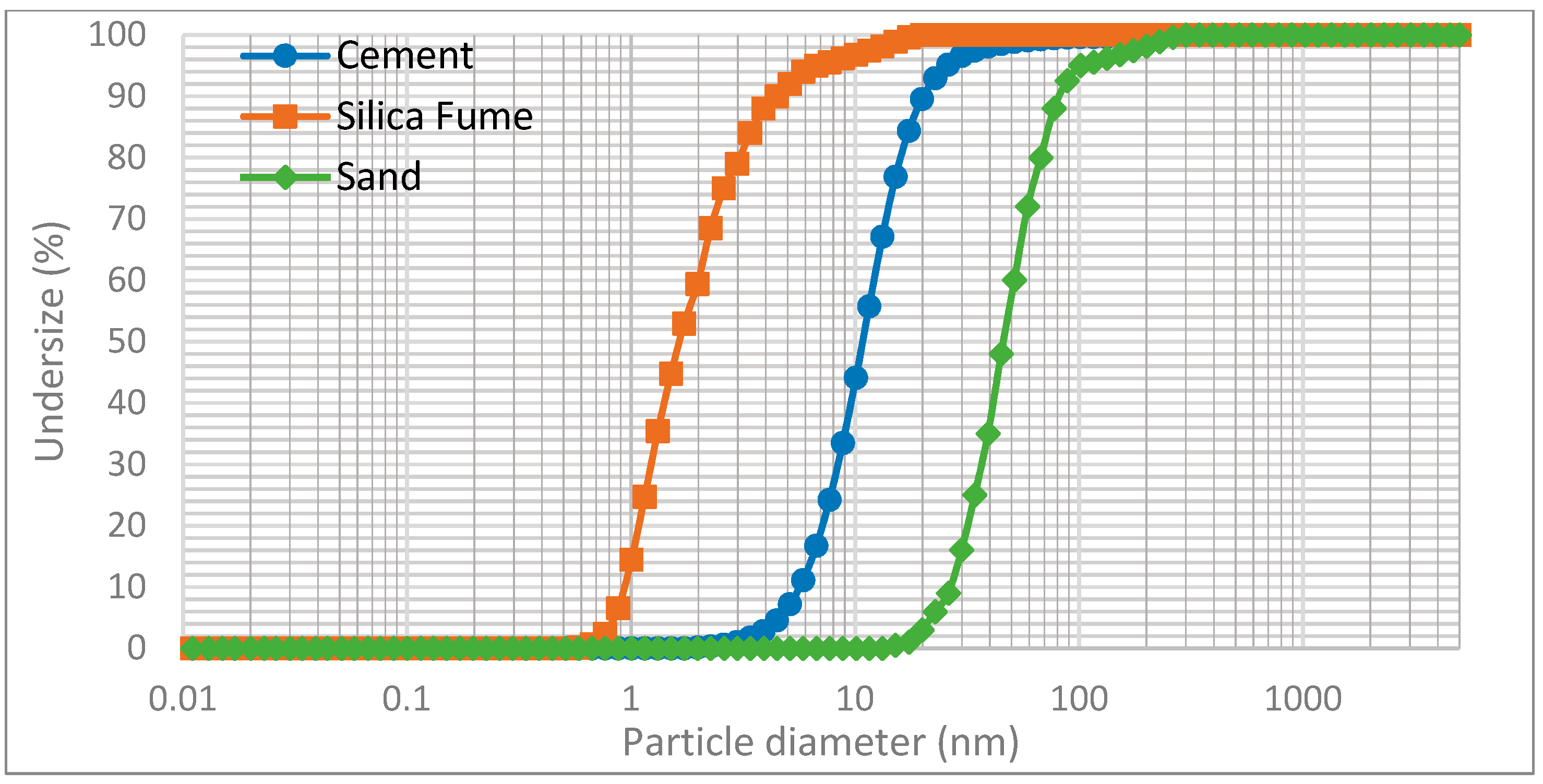
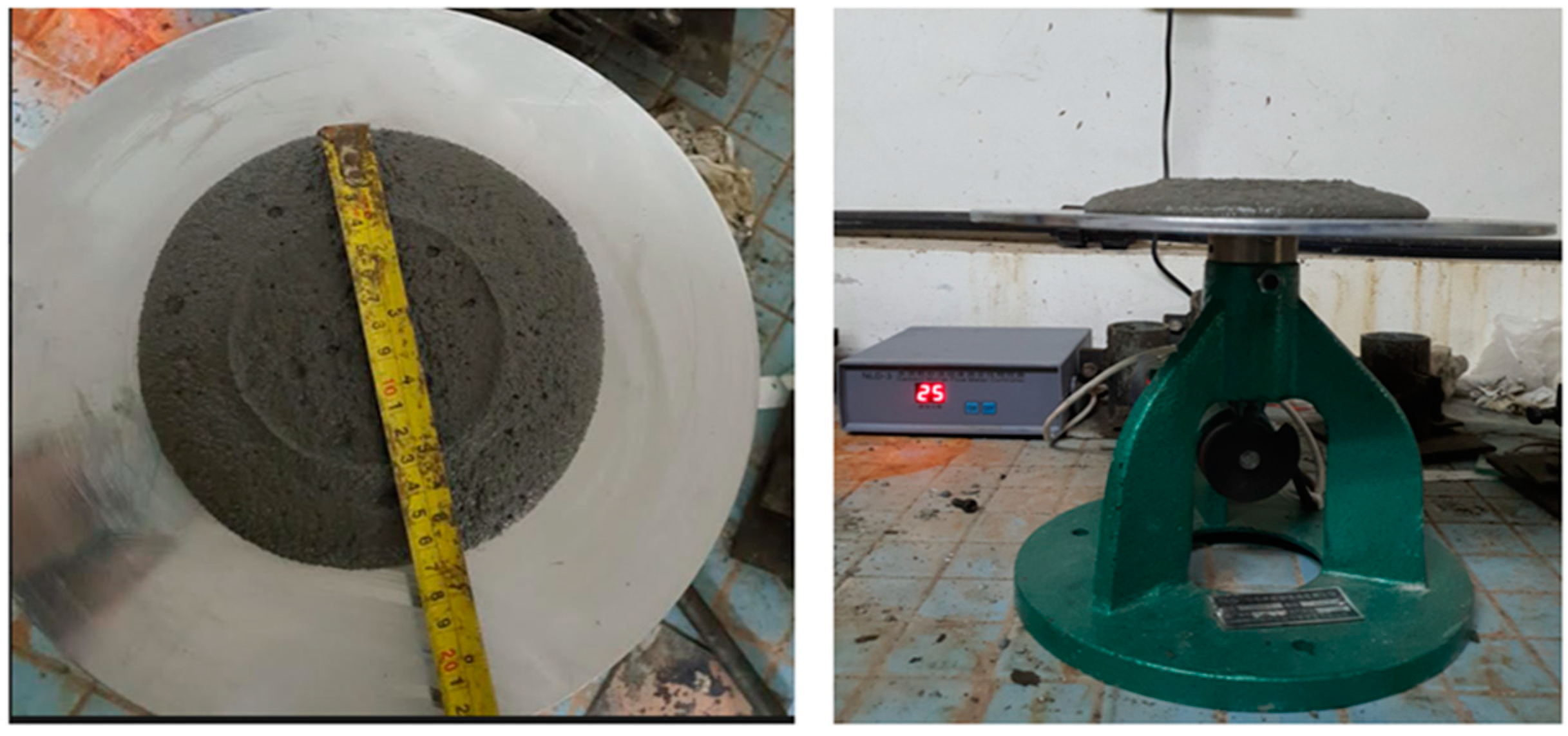
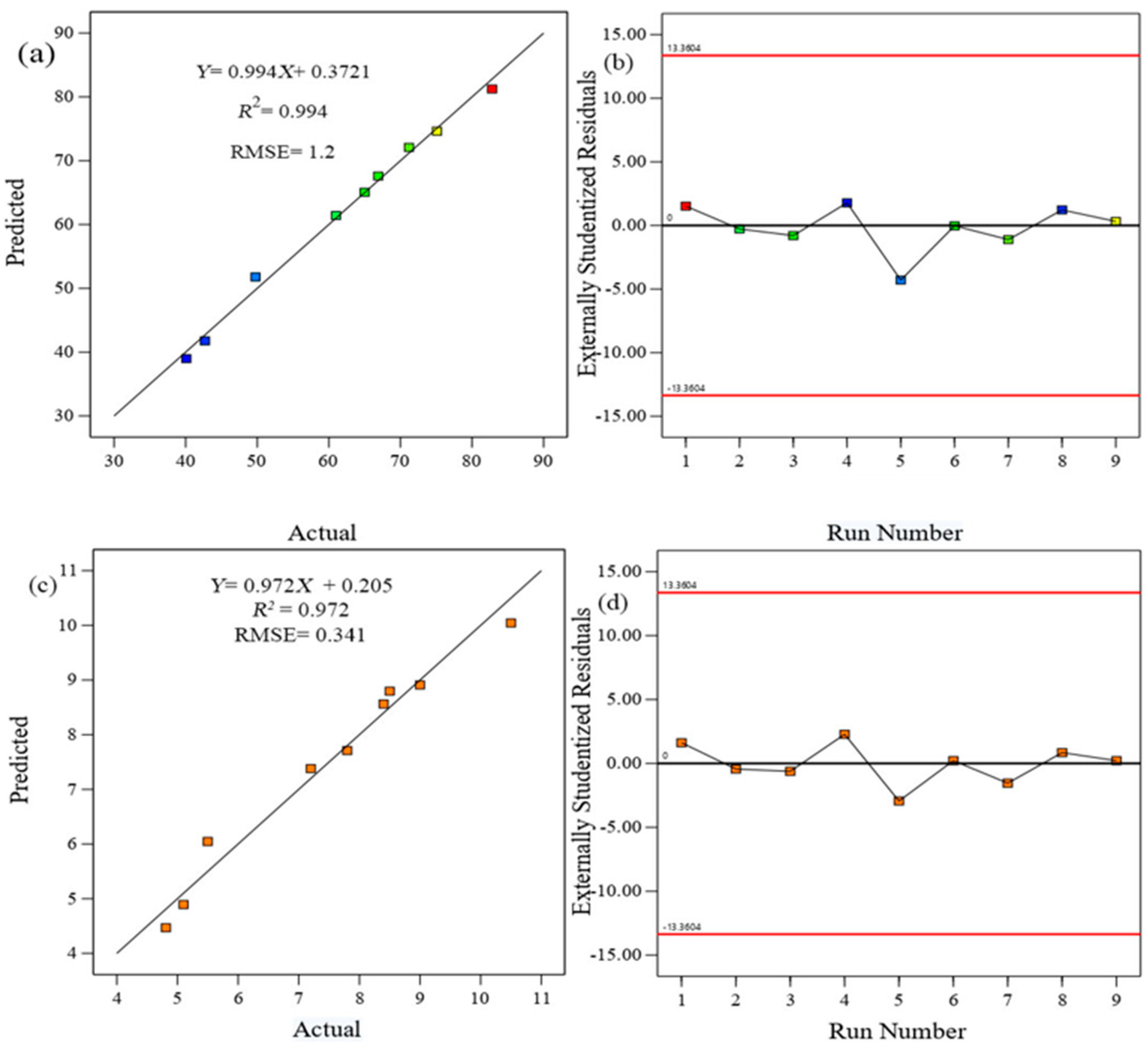

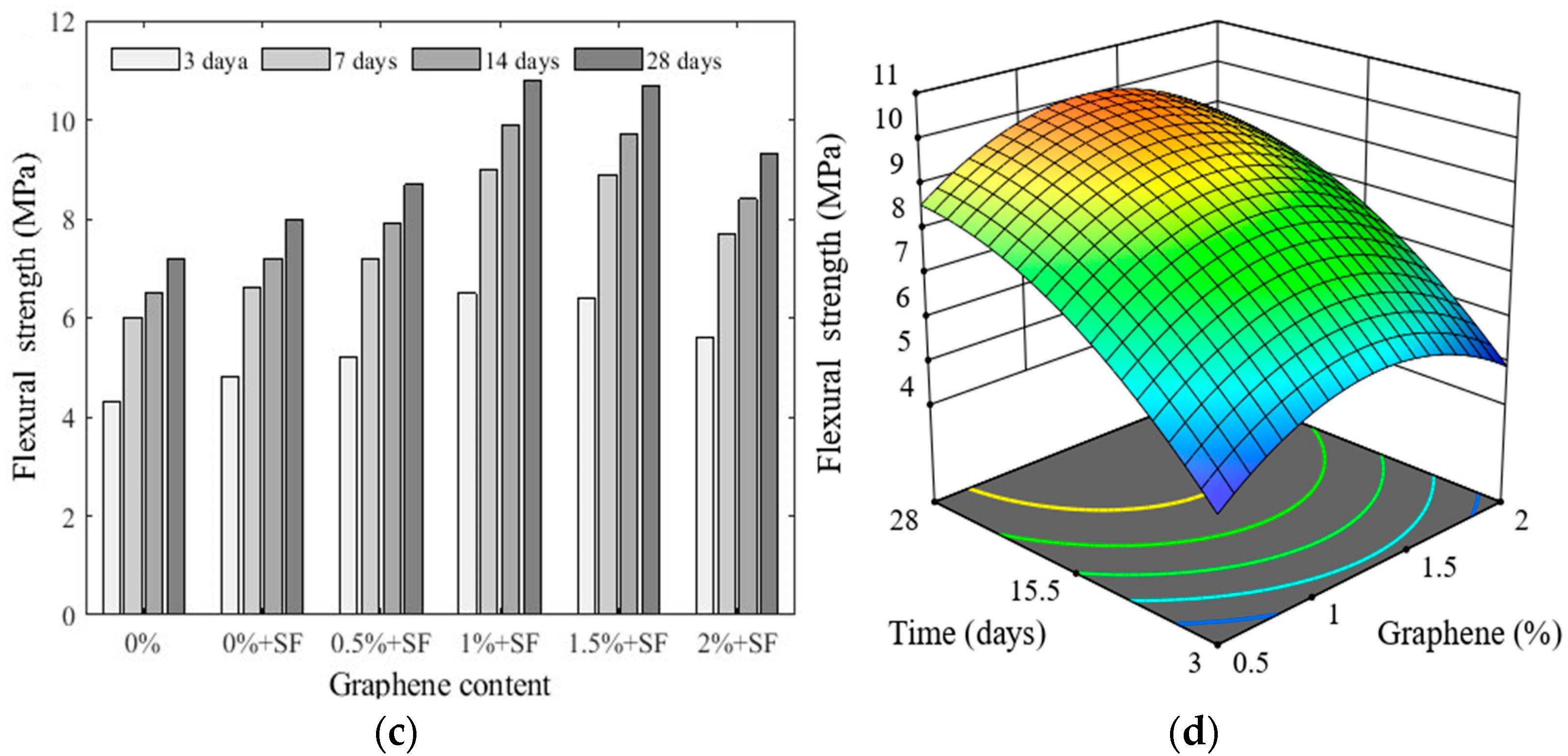
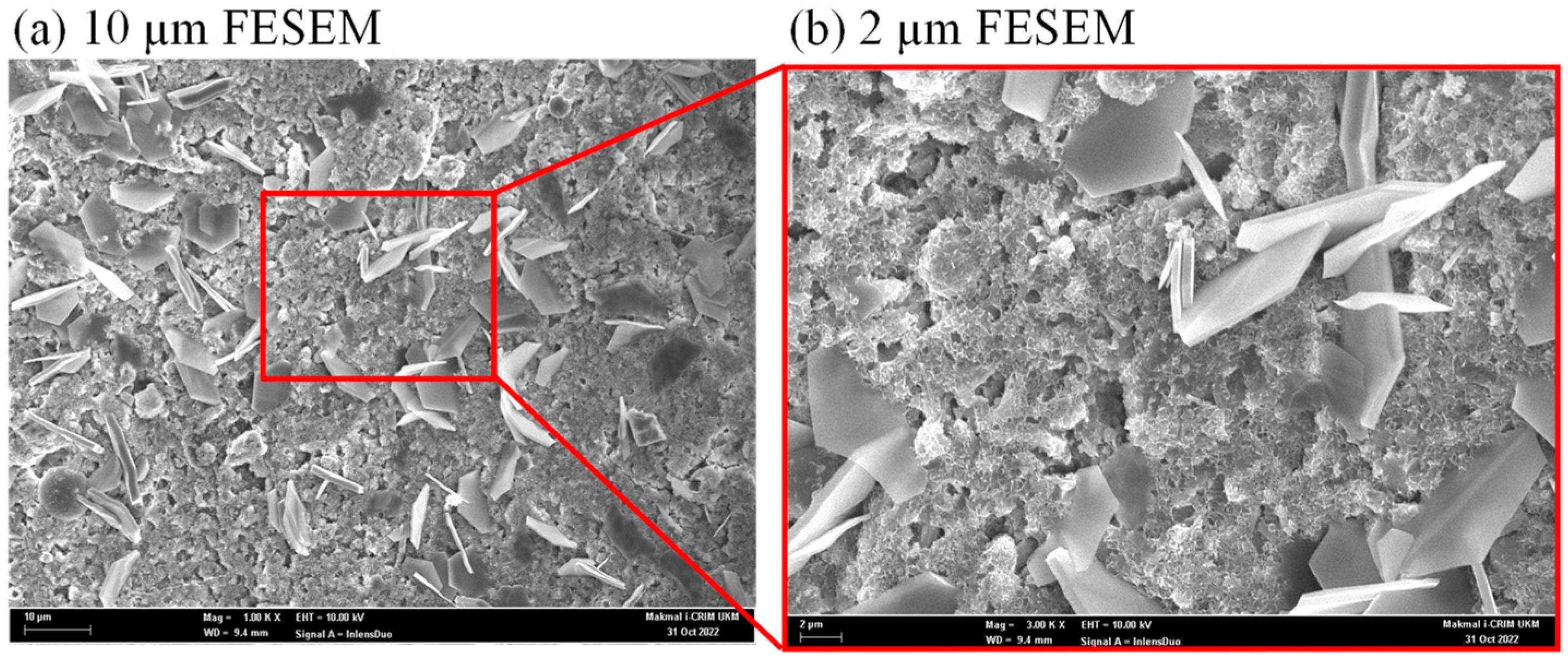

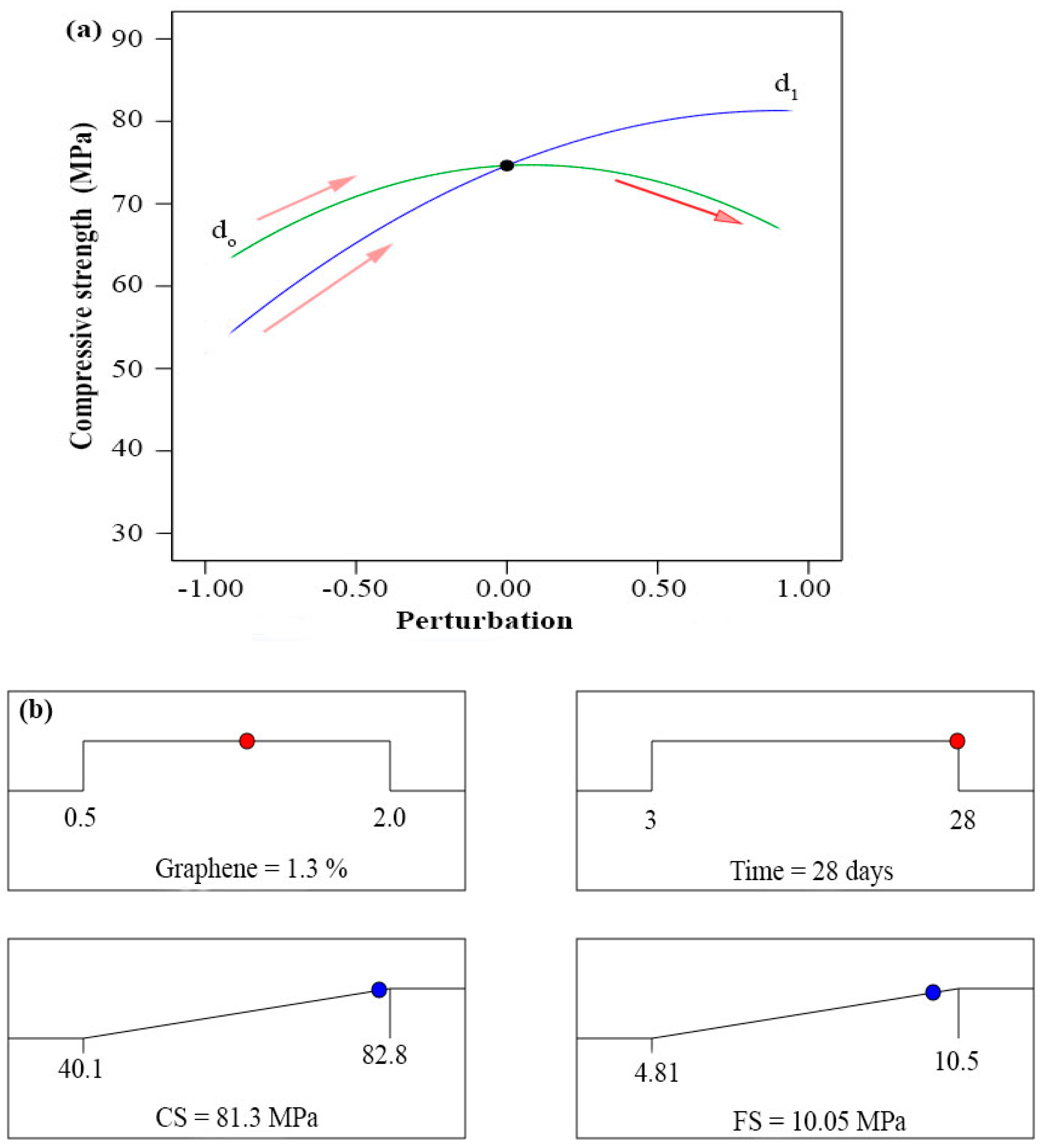
| Constituents | Mass Percentage % | |
|---|---|---|
| Silica Fume | Cement | |
| SiO2 | 96.00 | 15.9 |
| CaO | 0.27 | 69.8 |
| Al2O3 | 0.72 | 3.43 |
| MgO | 0.40 | 0.991 |
| SO3 | 0.19 | 4.32 |
| Fe2O3 | 0.10 | 3.93 |
| K2O | 0.83 | 0.94 |
| Na2O | 0.26 | 0.0773 |
| Others | 0.20 | n/a |
| LOI | 1.00 | n/a |
| Mix Code No. | Mixes (%) | Cement (kg/m3) | Silica Fume (kg/m3) | GNPs (kg/m3) | Water (kg/m3) | Fine Aggregate (kg/m3) | Superplasticizer 1% (kg/m3) |
|---|---|---|---|---|---|---|---|
| GNPs | |||||||
| C1 | 0 | 827 | 0 | 0.00 | 266.80 | 1241 | 7.44 |
| C2 | 0 | 744 | 83 | 0.00 | 266.80 | 1241 | 7.44 |
| M1 | 0.5 | 740.30 | 83 | 3.70 | 266.80 | 1241 | 7.44 |
| M2 | 1 | 736.56 | 83 | 7.44 | 266.80 | 1241 | 7.44 |
| M3 | 1.5 | 732.84 | 83 | 11.16 | 266.80 | 1241 | 7.44 |
| M4 | 2 | 729.12 | 83 | 14.88 | 266.80 | 1241 | 7.44 |
| No. of Experiment | (Independent Variables) | Coded Values | ||
|---|---|---|---|---|
| GNPs (%) | Time (Days) | Low | High | |
| Mix 1 | 0.5 | 3 | −1 | −1 |
| Mix 2 | 0.5 | 15 | −1 | 0 |
| Mix 3 | 0.5 | 28 | −1 | 1 |
| Mix 4 | 1.25 | 3 | 0 | −1 |
| Mix 5 | 1.25 | 15 | 0 | 0 |
| Mix 6 | 1.25 | 28 | 0 | 1 |
| Mix 7 | 2 | 3 | 1 | −1 |
| Mix 8 | 2 | 15 | 1 | 0 |
| Mix 9 | 2 | 28 | 1 | 1 |
Disclaimer/Publisher’s Note: The statements, opinions and data contained in all publications are solely those of the individual author(s) and contributor(s) and not of MDPI and/or the editor(s). MDPI and/or the editor(s) disclaim responsibility for any injury to people or property resulting from any ideas, methods, instructions or products referred to in the content. |
© 2023 by the authors. Licensee MDPI, Basel, Switzerland. This article is an open access article distributed under the terms and conditions of the Creative Commons Attribution (CC BY) license (https://creativecommons.org/licenses/by/4.0/).
Share and Cite
Salah, H.A.; Mutalib, A.A.; Algaifi, H.A.; Yahya, I.B.; Yusof, M.A.I.; Sakib, N.; Elsayed, M. Assessment of the Mechanical Properties of High Strength Mortar Incorporating Silica Fume and Graphene Nanoplatelets: Experimental and Mathematical Modeling. Sustainability 2023, 15, 8054. https://doi.org/10.3390/su15108054
Salah HA, Mutalib AA, Algaifi HA, Yahya IB, Yusof MAI, Sakib N, Elsayed M. Assessment of the Mechanical Properties of High Strength Mortar Incorporating Silica Fume and Graphene Nanoplatelets: Experimental and Mathematical Modeling. Sustainability. 2023; 15(10):8054. https://doi.org/10.3390/su15108054
Chicago/Turabian StyleSalah, Husam A., Azrul A. Mutalib, Hassan Amer Algaifi, Iskandar Bin Yahya, M. A. I. Yusof, Nazmus Sakib, and Mohamed Elsayed. 2023. "Assessment of the Mechanical Properties of High Strength Mortar Incorporating Silica Fume and Graphene Nanoplatelets: Experimental and Mathematical Modeling" Sustainability 15, no. 10: 8054. https://doi.org/10.3390/su15108054
APA StyleSalah, H. A., Mutalib, A. A., Algaifi, H. A., Yahya, I. B., Yusof, M. A. I., Sakib, N., & Elsayed, M. (2023). Assessment of the Mechanical Properties of High Strength Mortar Incorporating Silica Fume and Graphene Nanoplatelets: Experimental and Mathematical Modeling. Sustainability, 15(10), 8054. https://doi.org/10.3390/su15108054






